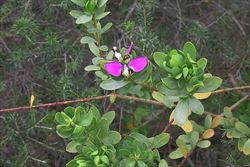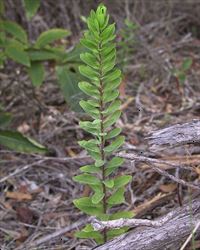Click on images to enlarge

habit (Photo: Jackie Miles and Max Campbell)

leaves and flowers (Photo: Jackie Miles and Max Campbell)

close-up of the relatively broad leathery leaves (Photo: Greg Jordan)

flowers (Photo: Steve Adkins)

young plant (Photo: Jackie Miles and Max Campbell)
Scientific Name
Polygala myrtifolia L.
Family
Polygalaceae
Common Names
Bellarine pea, myrtle leaf milkwort, myrtleleaf milk wort, myrtle-leaf milkwort, myrtleleaf milkwort, myrtle-leafed milkweed, myrtle-leaved milkweed, myrtle-leaved milkwort, myrtleleaved milkwort, parrot bush, polygala, September bush, sweet pea bush, sweet pea shrub
Origin
Native to southern Africa (i.e. Cape Province, Natal and Orange Free State in South Africa).
Cultivation
Myrtle-leaf milkwort (Polygala myrtifolia) has been widely cultivated as a garden ornamental, particularly in the temperate regions of Australia. The typical form of the species is generally no longer cultivated, but a modern cultivar (i.e. Polygala myrtifolia 'Grandiflora') is now widespread in cultivation. This cultivar was thought to be sterile, but it has recently been found to set some seed.
The two forms can be distinguished by the following differences:
- Polygala myrtifolia has bright pink or pale purple flowers and short, leathery, leaves with rounded tips.
- Polygala myrtifolia 'Grandiflora' has bright magenta or purple flowers with longer, thinner, leaves that have pointed tips.
Naturalised Distribution
Widely naturalised in the coastal districts of southern Australia (i.e. in the coastal districts of eastern New South Wales, Victoria, Tasmania, southern South Australia and south-western Western Australia). Less common in the sub-coastal and inland regions of Victoria, South Australia and south-western Western Australia. Also naturalised on Norfolk Island.
Naturalised overseas in New Zealand and south-western USA (i.e. California).
Habitat
A weed of coastal environs, open woodlands, grasslands and watercourses (i.e. riparian areas) in the temperate regions of Australia.
Habit
An upright (i.e. erect) shrub usually growing 1-2.5 m tall.
Distinguishing Features
- an upright shrub usually growing 1-2.5 m tall.
- its alternately arranged leaves (1-5 cm long and 6-15 mm wide) are relatively broad and borne on very shorts stalks.
- these leaves are relatively thick and leathery with entire margins and rounded tips.
- its flowers (1-2 cm long) are bright pink to pale purple and closely resemble pea flowers.
- these flowers have two spreading side 'petals' and a folded lower petal that is finely-branched at its tip.
- its fruit is a small rounded capsule (8-10 mm across).
Stems and Leaves
Its younger stems are hairless (i.e. glabrous) or have some fine curled hairs (i.e. sparsely pubescent).
The alternately arranged leaves (1-5 cm long and 6-15 mm wide) are usually oval (i.e. elliptic) in shape and borne on very short stalks (i.e. petioles) 1-2 mm long. They are relatively thick and leathery in nature with entire margins and rounded tips (i.e. obtuse apices). Leaves are hairless (i.e. glabrous) to sparsely hairy (i.e. puberulent).
Flowers and Fruit
The flowers are arranged in shortly elongated clusters and the tips of the branches (i.e. in terminal racemes) 1-5 cm long. These flowers (1-2 cm long) are pink to pale purple in colour and borne on stalks (i.e. pedicels) 5-10 mm long. The closely resemble pea-shaped flowers, but are actually quite different in structure. Each flower has five sepals, three of which are small and inconspicuous (4-5 mm long), and two of which are larger (10-15 mm long) and petal-like in appearance. Flowers also have three petals, two small side (i.e. lateral) petals and are larger folded lower petal (i.e. keel) about 10 mm long. The lower petal has two finely-branched structures (4-6 mm long) at its tip. Each flower also has eight stamens, with fused bases, and an ovary topped with a curved style and stigma. Flowering occurs throughout year, but mostly during spring (i.e. from September to October).
The fruit is a rounded (i.e. orbicular) capsule (8-10 mm across) with a small wing (about 1 mm wide) along one side. It contains several broadly egg-shaped (i.e. ovoid) to oblong seeds (about 4-5 mm long) that are covered with scattered hairs.
Reproduction and Dispersal
This species reproduces mainly by seed. These seeds are dispersed by birds, ants, wind, water and in dumped garden waste.
Environmental Impact
Myrtle-leaf milkwort (Polygala myrtifolia) is a significant environmental weed in Victoria and South Australia and a moderately important environmental weed in New South Wales, Tasmania and Western Australia. It was recently listed as a priority environmental weed in three Natural Resource Management regions.
Legislation
Not declared or considered noxious by any state government authorities.
Management
For information on the management of this species see the following resources:
- the Victorian Department of Sustainability and Environment Coastal Note on this species, which is available online at http://www.dpi.vic.gov.au.
- Muyt (2001), Bush Invaders of South-east Australia, pp. 207-208.
Similar Species
Myrtle-leaf milkwort (Polygala myrtifolia) is similar to broom milkwort (Polygala virgata). These species can be distinguished by the following differences:
- myrtle-leaf milkwort (Polygala myrtifolia) is a large spreading shrub with relatively broad leaves (more than 6 mm wide). Its flowers are borne in short clusters at the tips of the branches.
- broom milkwort (Polygala virgata) is a small slender shrub with narrow leaves (usually less than 6 mm wide). Its flowers are in long clusters at the tips of the branches.

